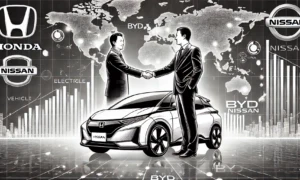In the competitive landscape of Indian e-commerce, where giants like Amazon and Flipkart dominate with massive inventories and logistical prowess, Blinkit (formerly Grofers) has carved a unique niche. By focusing on ultra-fast deliveries and a customer-first approach, Blinkit has revolutionized the quick-commerce model. This strategy has stunned its competitors and redefined urban shopping in India.
Here’s how Blinkit’s innovative approach turned it into a trailblazer in the quick-commerce sector and forced even established players to rethink their strategies.
The Cornerstones of Blinkit’s Strategy
1. Hyperlocal Fulfillment for Instant Delivery
Blinkit pioneered the use of hyperlocal dark stores—mini-warehouses located within urban neighborhoods—to drastically cut delivery times. Unlike traditional e-commerce logistics that rely on centralized warehouses, Blinkit’s decentralized network ensures that products are stored closer to customers.
This approach enables Blinkit to fulfill orders in 10–20 minutes, far outpacing the delivery speeds of Amazon and Flipkart. For urban consumers, especially in metros, this ultra-fast service makes Blinkit indispensable for last-minute purchases and emergencies.
2. Technology-Driven Efficiency
Blinkit’s operations hinge on advanced technology. From demand forecasting to route optimization, the company uses AI and machine learning to ensure smooth operations.
- Inventory Optimization: Blinkit tracks purchasing trends at the hyperlocal level to ensure dark stores stock high-demand items, minimizing out-of-stock issues.
- Dynamic Routing: Delivery routes are optimized in real-time to reduce delays and ensure efficiency.
- Personalized Recommendations: Using customer data, Blinkit offers tailored product suggestions, enhancing the shopping experience and driving higher conversion rates.
These technological advancements not only improve service quality but also reduce operational costs, ensuring the model remains scalable and profitable.
3. Customer-Centric Marketing
Blinkit has cleverly differentiated itself from Amazon and Flipkart by emphasizing convenience and speed over price competitiveness. Its marketing campaigns resonate with urban professionals and families who prioritize time savings.
For example:
- Ads showcasing relatable scenarios like unexpected guests arriving or urgent grocery needs emphasize Blinkit’s role in simplifying daily life.
- Emotional messaging strengthens customer loyalty by framing Blinkit as a reliable, go-to service for immediate needs.
4. Diversified Revenue Streams
While Amazon and Flipkart rely heavily on product sales, Blinkit has diversified its revenue model to ensure profitability:
- Commissions: Local partner stores pay Blinkit a commission of 12–15% on sales made through the platform.
- Delivery Fees: Customers are charged a nominal delivery fee for orders below a threshold value, ensuring sustainability even for smaller orders.
- Subscription Services: The Blinkit Plus membership offers benefits like free deliveries and exclusive discounts, creating recurring revenue streams while encouraging customer retention.
Expanding Product Categories: Beyond Groceries
Initially focused on grocery delivery, Blinkit has expanded its portfolio to include:
- Personal Care Products: From skincare to hygiene essentials.
- Electronics: Items like headphones and chargers for immediate needs.
- Household Items: Cleaning supplies and basic utilities.
This expansion has turned Blinkit’s dark stores into versatile mini-warehouses capable of fulfilling a wide range of customer needs. During the COVID-19 pandemic, this adaptability allowed Blinkit to pivot quickly, meeting increased demand for essentials like masks and sanitizers.
How Blinkit Outpaced Amazon and Flipkart
1. Focused Value Proposition
While Amazon and Flipkart cater to broad consumer needs with massive catalogs and nationwide delivery, Blinkit excels by addressing immediate, time-sensitive requirements. Its niche focus on quick delivery makes it irreplaceable for urban consumers.
2. Lean Operations
Amazon and Flipkart rely on extensive warehouses and nationwide logistics, which are costly and less suited for hyperlocal deliveries. Blinkit’s leaner, decentralized model enables faster operations with lower overhead.
3. Market Timing and Adaptability
Blinkit seized the opportunity presented by shifting consumer behaviors post-pandemic. With the demand for convenience-driven shopping surging, Blinkit adapted its offerings to address the needs of time-starved urban customers.
Challenges Blinkit Overcame
- High Operational Costs: Managing a dense network of dark stores and a fleet of delivery personnel required significant investment. Blinkit offset this by increasing its Average Order Value (AOV) through upselling and offering bundled products.
- Fierce Competition: In a crowded market with players like Swiggy Instamart and Zepto, Blinkit differentiated itself by focusing on speed, reliability, and customer experience.
Blinkit’s Broader Impact on E-Commerce
Blinkit’s success has forced traditional e-commerce players to re-evaluate their strategies:
- Amazon and Flipkart have started exploring same-day or rapid delivery services in select cities to stay competitive.
- The concept of quick commerce is now seen as essential for tapping into urban markets, especially for daily essentials.
What’s Next for Blinkit?
As Blinkit continues to scale, it plans to:
- Expand to Tier-2 Cities: Bringing quick commerce to smaller cities while tailoring offerings to local preferences.
- Strengthen Technology Infrastructure: Enhance AI-driven inventory and delivery models for better efficiency.
- Explore Partnerships: Collaborate with brands for exclusive product placements and promotions.
Conclusion
Blinkit’s rise showcases the power of innovation and agility in disrupting established markets. By focusing on hyperlocal delivery, leveraging technology, and staying attuned to customer needs, Blinkit has created a robust model that challenges even the biggest players like Amazon and Flipkart.
As the quick-commerce sector grows, Blinkit’s strategy serves as a blueprint for thriving in this competitive, fast-paced industry. It has proven that niche focus and operational excellence can lead to extraordinary success.


